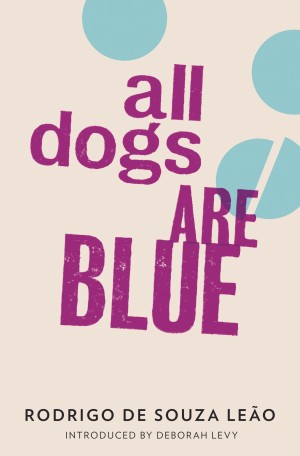
All Dogs Are Blue
by Rodrigo de Souza Leão; translated by Zoë Perry and Stefan Tobler
And Other Stories; 117 p.
Consider: the novel as rant, lament, or aria. Think Bolano’s short novels and Thomas Bernhard’s The Loser; think of Lydia Millet’s My Happy Life and Norman Lock’s The King of Sweden and Robert Lopez’s Kamby Bolongo Mean River. All feature protagonists whose minds are somehow askew, whether through a long and embittered life, mental illness, severe isolation, or some other condition that sets them apart from the rest of the world. All Dogs Are Blue, the final novel from the Brazilian author Rodrigo de Souza Leão, fits in neatly with that admirable tradition, and throws in an added dose of hardfought sentimentality to the proceedings. How you like that may well depend on how you reacted to that last sentence; for me, the novel’s pained, honest prose left me reeling for much of its length.
As Souza Leão’s Brazilian publisher notes in an afterword, this short novel’s success in Brazil did not come until after its author’s death. It’s an unlikely choice for cult-book status; it follows the observations of an institutionalized man in Rio as he follows daily routines, converses with possibly imaginary friends, and interacts with other patients and his family. Souza Leão’s prose works in rhythms; his narrator often circles a given topic, sometimes glibly eliding it and at others contradicting himself, offering multiple takes on one point of order. Consider:
The first taste of freedom is leaving the cubicle. The second is walking around the asylum. Freedom itself only happens outside the asylum. But real freedom doesn’t exist. Heading for freedom, I always run smack into someone. If there were freedom, the world would be one big madhouse with everyone in it.
He’s also acutely aware of bodies. “I swallowed a chip yesterday,” the novel begins — and, yes, some of the observations made about the narrator’s body appear to be entirely delusional. Other moments of physicality seem more grounded, from his musings on his own weight (which seems excessive) to matter-of-fact allusions to masturbation. As he speaks in circles, a sort of portrait emerging out of areas exposed and covered. It also doesn’t hurt that the cyclical, obsessive prose can yield utterly gorgeous passages.
Why drink coffee with sugar when you’re fat? Everything with lots of sugar. I look at clocks and coffee cups. I spit soap bubbles. I turn into a train that goes along without knowing where to stop. I transform myself into a writing machine and it writes whatever I want it to write.
When he gets going, the headlong rush of prose and ideas becomes breathtaking. And — though it may be something of a cliché — it makes a relatively confined narrative much more open. The specifics and obsessions that occur throughout the book, the names of drugs and fellow patients and the memories of childhood and of more recent street scenes all feel seared into place. But it’s a more universal motif that ultimately makes All Dogs Are Blue resonate at a welcoming pitch.
The title references a stuffed animal owned by the narrator. As Deborah Levy points out in her introduction, it may also be a nod to Winston Churchill’s “black dog” — i.e., his personification of depression. As befits a beloved stuffed animal owned since childhood, there is more than a little sentimentality present there — but it also serves as a kind of anchor for the novel as a whole, grounding the narrator in at least one object. That this object is a toy dog with a decidedly unreal color is a fine touch, a moving detail in bright colors. And for all of the things that we don’t know about this brief, crushingly moving book’s narrator, we do know that he was once a child; we can experience something of that innocence, and the heart at his core. It’s an indication of why we should care about this man, and what warm decency lies at the beginnings of this particular narrative.
Follow Vol. 1 Brooklyn on Twitter, Facebook, Google +, our Tumblr, and sign up for our mailing list.
